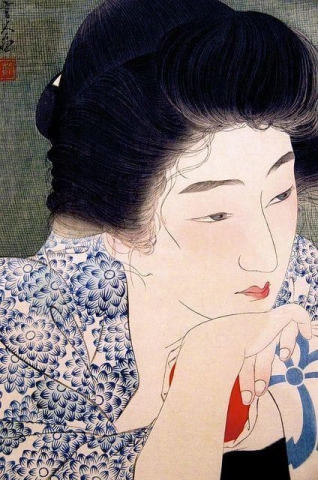

Hand painted reproductions of Kotondo Torii
Kotondo Torii: A Master of Shin-hanga and Japanese Beauty
Early Life and Artistic Development
Kotondo Torii (1900–1976) was a prominent Japanese artist of the Shin-hanga (new prints) movement, renowned for his evocative bijin-ga (portraits of beautiful women). Born in Tokyo, Kotondo was the adopted son of Torii Kiyotada VII, the head of the Torii school of kabuki theater art, which specialized in woodblock prints. This rich artistic heritage deeply influenced Kotondo’s development.
Kotondo initially studied under Kaburagi Kiyokata, a master of modern bijin-ga. Under Kiyokata’s tutelage, he refined his skills in drawing and woodblock design, adopting the stylistic elegance and technical precision that would define his career.
Key Works and Signature Style
Kotondo’s portfolio includes a limited but highly prized series of bijin-ga, characterized by their serene elegance and psychological depth. Iconic works such as Morning Hair (1930) and Woman Applying Powder highlight his mastery of light, shadow, and delicate detailing.
His women are often depicted in quiet, intimate moments, emphasizing mood and emotion over external action. With a restrained use of color and meticulous composition, Kotondo created prints that exude timeless grace. Unlike many of his contemporaries, he frequently collaborated with printers to achieve rich textures and luminous effects, making each piece a testament to craftsmanship.
Technique and Artistic Innovations
Kotondo’s innovative approach to Shin-hanga included the use of nuanced color gradations and finely detailed carving. His works are notable for their soft textures, achieved through layering and the skilled application of pigments. This technique brought a lifelike quality to his prints, capturing the subtleties of fabric, hair, and skin.
Another distinctive feature of Kotondo’s art is his focus on light and shadow to create a sense of depth and atmosphere. This attention to realism blended seamlessly with the stylized elegance of traditional Japanese woodblock prints, bridging the gap between the classical and the modern.
Legacy and Enduring Influence
Kotondo Torii remains a revered figure in the Shin-hanga movement, with his works celebrated for their artistic beauty and cultural significance. Although his output was relatively small—fewer than 30 designs—each print is considered a masterpiece, sought after by collectors worldwide.
His contributions elevated the portrayal of women in Japanese art, presenting them with dignity and individuality. Kotondo’s influence extends beyond his era, inspiring modern artists and preserving the rich traditions of bijin-ga and woodblock printing for future generations.
Where to Buy Reproductions of Kotondo Torii’s Work
Explore the serene beauty of Kotondo Torii’s art with high-quality reproductions available at [POD]. From his iconic bijin-ga to his exquisite use of light and texture, these reproductions offer a gateway to the refined elegance of Shin-hanga. Ideal for collectors and admirers of Japanese woodblock prints, these pieces bring Kotondo’s timeless artistry to your home.
Imagine owning an original work of art by Kotondo Torii, one of the greatest artists in history. At POD we offer you the opportunity to make this dream come true. We reproduce Kotondo Torii's works down to the smallest detail, so you can enjoy them in your own home.
Our reproductions are made by experienced artists who use the best materials and techniques. We are dedicated to providing you with the highest quality works of art, which will bring joy and inspiration to your family for generations.





